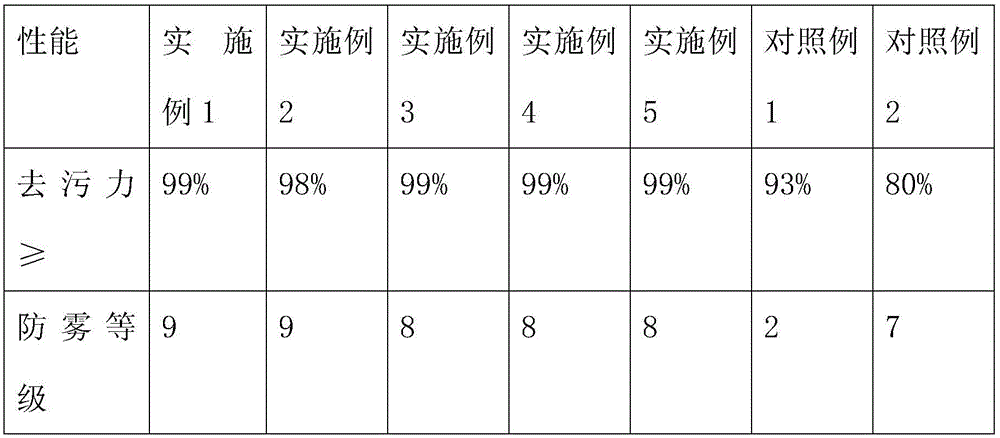Glass cleaning agent with antifogging function
A technology of glass cleaning agent and anti-fogging agent, which is applied in the direction of detergent composition, detergent compounding agent, organic cleaning composition, etc. It can solve the problems of hindering driving safety, affecting the driver's sight, and the effect is not obvious, so as to achieve the goal of cleaning Good effect and convenient effect in daily life
- Summary
- Abstract
- Description
- Claims
- Application Information
AI Technical Summary
Problems solved by technology
Method used
Image
Examples
Embodiment 1
[0017] Example 1: A glass cleaning agent with anti-fogging function, including the following raw materials in weight percentage:
[0018] Polyoxyethylene octylphenol ether 16%, polyoxyethylene coconut acid ether 4%, nonylphenol polyoxyethylene ether 0.5%, dichlorotetrafluoroethane 2%, trinitrotoluene 0.2%, non-ionic surface activity Agent 0.2%, anti-fogging agent 25%, adjuvant 0.1%, deionized water 52.0%; the non-ionic surfactant is a surfactant commonly used in detergent field except nonylphenol polyoxyethylene ether.
[0019] Further, the antifogging agent is a compound of polyvinylpyrrolidone, fatty alcohol polyoxyethylene ether, propanol, and isopropanol, and the polyvinylpyrrolidone, fatty alcohol polyoxyethylene ether, propylene The mass ratio of alcohol to isopropanol is 1:1:8:25.
[0020] Further, the auxiliary agent is a composite of dye and perfume, and the dye and perfume are commonly used additives in the detergent field.
[0021] Further, the pH of the glass cleaning age...
Embodiment 2
[0027] Embodiment 2: A glass cleaning agent with anti-fogging function, including the following raw materials in weight percentage:
[0028] Polyoxyethylene octylphenol ether 20%, polyoxyethylene coconut acid ether 2%, nonylphenol polyoxyethylene ether 0.8%, dichlorotetrafluoroethane 2%, trinitrotoluene 0.3%, non-ionic surface activity Agent 0.1%, anti-fogging agent 30%, auxiliary agent 0.1%, deionized water 44.7%.
[0029] Further, the antifogging agent is a compound of polyvinylpyrrolidone, fatty alcohol polyoxyethylene ether, propanol, and isopropanol, and the polyvinylpyrrolidone, fatty alcohol polyoxyethylene ether, propylene The mass ratio of alcohol to isopropanol is 1:2:5:30.
[0030] Further, the auxiliary agent is perfume.
[0031] Further, the pH of the glass cleaning agent is 7.0 to 9.0.
Embodiment 3
[0032] Embodiment 3: A glass cleaning agent with anti-fog function, including the following raw materials in weight percentage:
[0033] Polyoxyethylene octylphenol ether 12%, polyoxyethylene coconut acid ether 5%, nonylphenol polyoxyethylene ether 0.3%, dichlorotetrafluoroethane 2%, trinitrotoluene 0.3%, non-ionic surface activity Agent 0.4%, anti-fogging agent 20%, auxiliary agent 0.2%, deionized water 59.8%.
[0034] Further, the antifogging agent is a compound of polyvinylpyrrolidone, fatty alcohol polyoxyethylene ether, propanol, and isopropanol, and the polyvinylpyrrolidone, fatty alcohol polyoxyethylene ether, propylene The mass ratio of alcohol to isopropanol is 2:3:15:43.
[0035] Further, the auxiliary agent is a compound of dye and perfume.
[0036] Further, the pH of the glass cleaning agent is 7.0 to 9.0.
PUM
 Login to View More
Login to View More Abstract
Description
Claims
Application Information
 Login to View More
Login to View More - R&D
- Intellectual Property
- Life Sciences
- Materials
- Tech Scout
- Unparalleled Data Quality
- Higher Quality Content
- 60% Fewer Hallucinations
Browse by: Latest US Patents, China's latest patents, Technical Efficacy Thesaurus, Application Domain, Technology Topic, Popular Technical Reports.
© 2025 PatSnap. All rights reserved.Legal|Privacy policy|Modern Slavery Act Transparency Statement|Sitemap|About US| Contact US: help@patsnap.com


